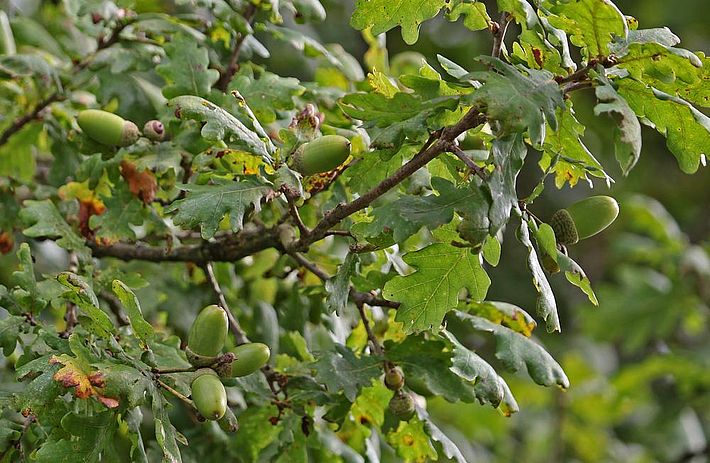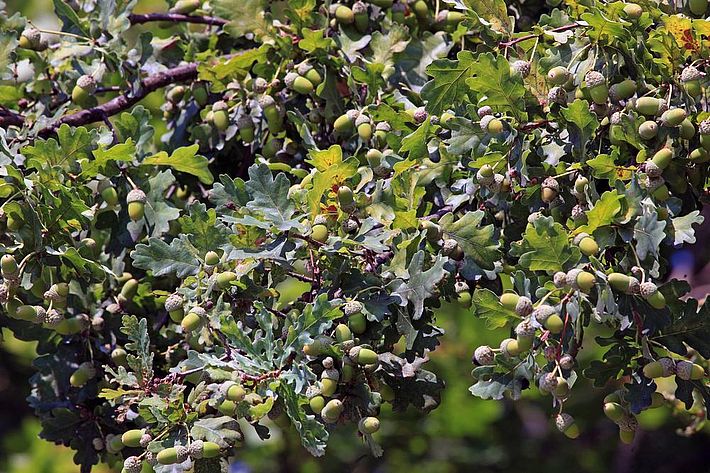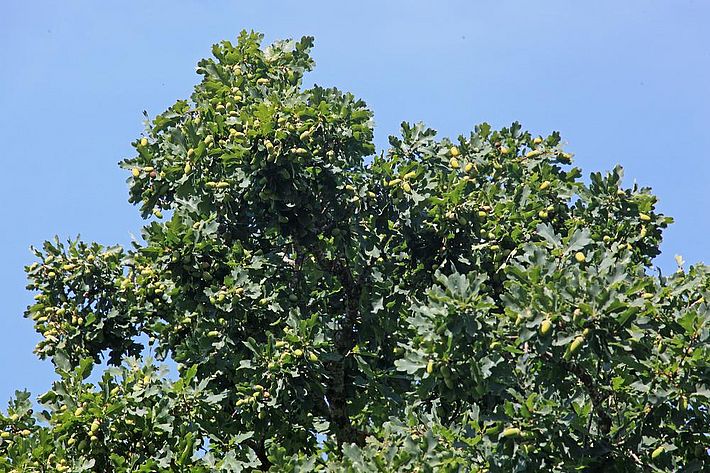Quercus robur L. | F: Chêne pédonculé | I: Quercia farnia | R: Ruver cumin/tempriv | D: Stileiche ¶
General information on the pedunculate oak ¶
The pedunculate oak needs a lot of light and a long, warm growing season1. Therefore, it usually grows below 800 m a.s.l. and is mainly widespread on the Central Plateau and in the eastern Jura1.
Blooming ¶
As with all beech plants (Fagaceae), the flowers of the pedunculate oak are unisexual and the male flowers are in a pendulous spike, a so-called catkin (Fig. 1). The pedunculate oak flowers from mid-April to the end of May.
Fruits ¶
The acorns are surrounded by a woody fruit cupule, the so-called cupula (Fig. 2). In contrast to the Sessile Oak, the fruits of the pedunculate oak are in twos or threes on long stalks (Fig. 2). They are ripe in October and are largely eaten by wild animals before they germinate2. However, jays and squirrels, which store acorns for the winter, also contribute to seed dispersal. Acorns remain germinable for only a short time and do not form a seed bank.
Seed masting behaviour ¶
Oaks show a distinct masting behaviour, with years of high seed production occurring relatively frequently in our latitudes, namely every 2 to 3 years3. So far, it is unclear which factors trigger or prevent oak masting. Connections with climatic factors vary regionally3. In contrast to beech and spruce, pollen quantity does not seem to be an indicator of seed production4. Due to their high-calorie content5 acorns are an important food source for many wild animals2. In the canton of Zurich, for example, the shooting numbers of wild boar in mast years are more than twice as high as in years when acorns are absent3.
Assessment of seed mast ¶
Time: August to the end of September.
Assessment of fruiting intensity: Seed masting is a phenomenon that does not affect the individual tree but encompasses entire stands in a larger geographical area. The intensity of an oak mast can be assessed according to the following key:

1 Brändli UB (1996) Die häufigsten Waldbäume der Schweiz. Ber. Eidg. Forsch.anst. Wald Schnee Landsch. 342
2 Gurnell J (1993) Tree seed production and food conditions for rodents in an oak wood in southern England. Forestry 66: 291-315
3 Wohlgemuth T, Nussbaumer A, Burkart A, Bollmann K (2016) Eichenmast und Wildschweine. Zürcher Wald 3/16: 28-30
4 Kasprzyk I, Ortyl B, Dulska-Jeż A (2014) Relationships among weather parameters, airborne pollen and seed crops of Fagus and Quercus in Poland. Agricultural and Forest Meteorology 197: 111-122
5 Kallman S (1991) Nutritive value of Swedish wild plants. Svensk Botanisk Tidskrift 85: 397-411
Download ¶



